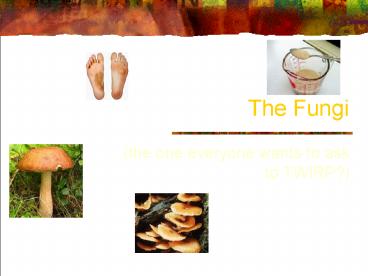The Fungi - PowerPoint PPT Presentation
1 / 19
Title:
The Fungi
Description:
The Fungi (the one everyone wants to ask to TWIRP?) Main Ideas Characteristics of Fungi Fungal Forms Classification of Fungi I. Characteristics of Fungi Made of ... – PowerPoint PPT presentation
Number of Views:117
Avg rating:3.0/5.0
Title: The Fungi
1
The Fungi
- (the one everyone wants to ask to TWIRP?)
2
Main Ideas
- Characteristics of Fungi
- Fungal Forms
- Classification of Fungi
3
I. Characteristics of Fungi
- Made of eukaryotic cells
- 1. Eukaryotic cells have a nucleus (prokaryotic
cells do not) - 2. Animal and plant cells are also eukaryotic
- 3. Fungal cells have a cell wall (animal cells
do not).
4
I. Characteristics of Fungi
- Release exoenzymes into their surroundings
- 1. Fungi digest 1st, then ingest (we ingest,
then digest) - 2. This allows the fungi to be decomposers
- 3. Fungi DO NOT PHOTOSYNTHESIZE they must
obtain food from another source (heterotrophs).
5
I. Characteristics of Fungi
- Made of hyphae microscopic tubular filaments
composed of repeating cells. - 1. Hyphae grow and increase a funguss surface
area. - 2. A mass of interwoven hyphae is called a
mycelium (plural mycelia) - 3. Mycelia are usually beneath the surface
- 4. Mycelia can be massive
6
(No Transcript)
7
The Humongous Fungus of Oregon - Armillaria
ostoyae
- Covers an area equivalent to 1,600 football
fields!! - At least 2,400 years old!!
- Estimated to weigh hundreds of tons!!
8
I. Characteristics of Fungi
- Reproduce through spores
- 1. Can be produced asexually and/or sexually
- 2. Fruiting body structure built for
dispersing spores - 3. Spores dispersed mainly through wind
- 4. Asexual stage Imperfect stage
- Sexual stage Perfect stage
9
Main Ideas
- Characteristics of Fungi
- Fungal Forms
- Classification of Fungi
10
II. Fungal Forms
- A. Yeast
- 1. Some fungi exist only as yeast others can
exist either as yeast or mycelia depending on
conditions - 2. Yeast reproduce asexually by budding
11
II. Fungal Forms
- A. Yeast (cont.)
- 3. Examples bakers yeast (Saccharomyces
cerevisiae) - -human yeast infections (Candida albicans)
- 4. Uses in biotechnology
- a. Fermentation
- b. Study of molecular genetics in
eukaryotes.
12
II. Fungal Forms
- Molds
- 1. Rapidly growing, asexually reproducing
fungi - 2. Can spoil bread, fruits, and cheeses
- 3. Importance in biotech
- a. Fermentation
- b. Penicillin
13
II. Fungal Forms
- Mushrooms
- Cups
- Shelf Fungi
- Puffballs
14
Main Ideas
- Characteristics of Fungi
- Fungal Forms
- Classification of Fungi
15
III. Classification of Fungi
- Saprophytes
- 1. Feed on dead organic matter the
decomposers - 2. Important to ecosystems for recycling
carbon, nitrogen, and other nutrients.
16
III. Classification of Fungi
- Parasites are harmful to another organism
- 1. Human athletes foot, yeast infections,
ringworm. - 2. Over 70 of plant diseases are fungal (eg.
Dutch Elm Disease) - 3. Can also infect other microbes!
- http//www.youtube.com/watch?vjOwCOLf0IRUfeatu
rerelated
17
III. Classification of Fungi
- C. Mutualists are beneficial to another
organism - 1. Lichen association of a fungus with algae
18
III. Classification of Fungi
- C. Mutualists (cont.)
- 2. Mycorrhizae association of a fungus with
plant roots - a. fungi extend the reach of plant roots
- b. nearly all plants have mycorrhizae
- c. plants get more minerals from soil fungus
gets organic nutrients from plant
19
(No Transcript)

